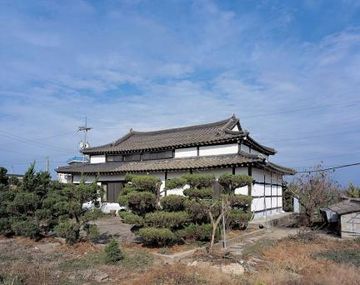"김제 종신리 한·일 절충식 가옥"의 두 판 사이의 차이
| 29번째 줄: | 29번째 줄: | ||
===영문=== | ===영문=== | ||
'''Eclectic-style House in Jongsin-ri, Gimje''' | '''Eclectic-style House in Jongsin-ri, Gimje''' | ||
| + | |||
| + | This house was built in 1936 during the Japanese Colonial period (1910-1945) on a Japanese-owned farmland. Gimje has been the largest rice basket in Korea for the vast plain. During the colonial period, however, Japanese landowners operating large-scale farms in the area plundered the land and shipped extensive amounts of rice to Japan. This house was built for one of such Japanese landowners, and he accumulated such wealth that his tax payment was the largest among those in the Gimje area. He is said to have arranged bringing Japanese timber to build this house. | ||
| + | |||
| + | While the main structure of this house and the outside walls coated with cement exhibit Japanese architectural style, the way of constructing the roof is Korean which makes this house an eclectic style. The original tin roof was replaced to a tiled-roof. For convenience, the interior structure was partially renovated from the original traditional-style, such as the kitchen. | ||
| + | |||
| + | *“내부 공간을 입식으로 개조하였다”는 말이 무슨 뜻인지 잘 모르겠습니다... 링크된 자료를 보니 부엌을 입식으로 개조했다길래 번역에 반영했습니다. | ||
===영문 해설 내용=== | ===영문 해설 내용=== | ||
2020년 5월 17일 (일) 22:40 판
| 김제 종신리 한·일 절충식 가옥 Eclectic-style House in Jongsin-ri, Gimje |
|
 김제 종신리 한·일 절충식 가옥, 국가문화유산포털, 문화재청. |
|
| 대표명칭 | 김제 종신리 한·일 절충식 가옥 |
|---|---|
| 영문명칭 | Eclectic-style House in Jongsin-ri, Gimje |
| 한자 | 金堤 宗新里 韓·日 折衷式 家屋 |
| 주소 | 전북 김제시 죽산면 종남길 233 (종신리) |
| 지정번호 | 국가등록문화재 제220호 |
| 지정일 | 2005년 12월 9일 |
| 분류 | 등록문화재/기타/주거숙박시설 |
| 시대 | 일제강점기 |
| 수량/면적 | 1동, 2층, 연면적 168.26㎡ |
| 웹사이트 | 김제 종신리 한·일 절충식 가옥, 국가문화유산포털, 문화재청. |
|
|
|
해설문
국문
김제 종신리 한ㆍ일 절충식 가옥은 1936년경에 전국 최대 쌀 생산 지역인 김제의 일본인 농장에 지어진 가옥이다. 당시 이 주택의 소유주였던 일본인은 김제에서 가장 많은 세금을 낼 정도의 재산을 가졌으며, 일본에서 직접 가져온 목재로 이 가옥을 지었다고 한다.
건물의 전체적인 구조와 시멘트로 마감한 외벽 등은 일본식이나, 지붕은 한옥 건축 기법을 사용한 절충식으로 세워졌다. 세워질 당시 함석이었던 지붕은 근래에 기와로 교체하였고, 생활의 편의를 위해 내부 공간은 입식으로 개조하였다. 보존상태가 양호하고, 외래 건축양식이 반영되었으며 한국의 주거 양식이 근대적으로 변화한 과정을 보여준다는 점에서 가치가 있다.
영문
Eclectic-style House in Jongsin-ri, Gimje
This house was built in 1936 during the Japanese Colonial period (1910-1945) on a Japanese-owned farmland. Gimje has been the largest rice basket in Korea for the vast plain. During the colonial period, however, Japanese landowners operating large-scale farms in the area plundered the land and shipped extensive amounts of rice to Japan. This house was built for one of such Japanese landowners, and he accumulated such wealth that his tax payment was the largest among those in the Gimje area. He is said to have arranged bringing Japanese timber to build this house.
While the main structure of this house and the outside walls coated with cement exhibit Japanese architectural style, the way of constructing the roof is Korean which makes this house an eclectic style. The original tin roof was replaced to a tiled-roof. For convenience, the interior structure was partially renovated from the original traditional-style, such as the kitchen.
- “내부 공간을 입식으로 개조하였다”는 말이 무슨 뜻인지 잘 모르겠습니다... 링크된 자료를 보니 부엌을 입식으로 개조했다길래 번역에 반영했습니다.
영문 해설 내용
이 가옥은 일제강점기인 1936년 일본인 농장에 지어진 주택이다. 김제 지역은 넓은 평야가 펼쳐져 있어 예로부터 한국 최대의 쌀 생산 지역이었다. 일제강점기에는 일본인들이 들어와 대규모의 농장을 경영하며 쌀을 수탈하여 일본으로 반출하였다. 당시 이 집의 소유주였던 일본인은 김제에서 가장 많은 세금을 낼 정도로 많은 부를 축적했으며, 일본에서 직접 가져온 목재로 이 집을 지었다고 한다.
건물의 전체적인 구조와 시멘트로 마감한 외벽 등은 일본식이나, 지붕은 한옥 건축 기법을 사용한 절충식으로 세워졌다. 건립 당시 함석이었던 지붕은 기와로 교체하였으며, 생활의 편의를 위해 내부 공간은 입식으로 개조하였다.
참고자료
- 近代化過程에 나타난 重二層 韓屋의 木架構法에 관한 硏究, 청주대학교 석사학위논문, 2004.
- → 집의 구조 및 배치 자세히 설명되어 있음.
- 근대문화유산 목록화 및 조사보고서(전라북도, 2004) https://m.blog.naver.com/PostView.nhn?blogId=jcjkks&logNo=220246423659&proxyReferer=https%3A%2F%2Fwww.google.com%2F